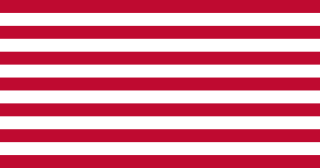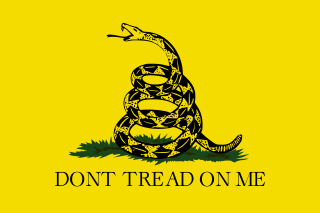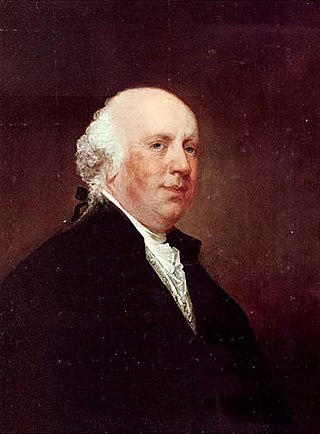
The American Revolutionary War, also known as the Revolutionary War or American War of Independence, was the military conflict of the American Revolution in which American Patriot forces under George Washington's command defeated the British, establishing and securing the independence of the United States. Fighting began on April 19, 1775, at the Battles of Lexington and Concord. The war was formalized and intensified following passage of the Lee Resolution, which asserted that the Thirteen Colonies were "free and independent states", by the Second Continental Congress in Philadelphia on July 2, 1776, and the unanimous ratification of the Declaration of Independence two days later, on July 4, 1776.

1783 (MDCCLXXXIII) was a common year starting on Wednesday of the Gregorian calendar and a common year starting on Sunday of the Julian calendar, the 1783rd year of the Common Era (CE) and Anno Domini (AD) designations, the 783rd year of the 2nd millennium, the 83rd year of the 18th century, and the 4th year of the 1780s decade. As of the start of 1783, the Gregorian calendar was 11 days ahead of the Julian calendar, which remained in localized use until 1923.

The Continental Congress was a series of legislative bodies, with some executive function, for the thirteen colonies of Great Britain in North America, and the newly declared United States before, during, and after the American Revolutionary War. The Continental Congress refers to both the First and Second Congresses of 1774–1781 which, at the time, also described the Congress of the Confederation of 1781–1789, which operated as the first national government until being replaced following ratification of the U.S. Constitution. The Continental Congress represented the 13 colonies and then the new United States from 1774 until 1789. The Congress met predominantly at Independence Hall in Philadelphia, though it was relocated temporarily on several occasions during the Revolutionary War and the fall of Philadelphia.

The Continental Army was the army of the United Colonies representing the Thirteen Colonies and later the United States during the American Revolutionary War. It was formed on June 14, 1775 by a resolution passed by the Second Continental Congress, meeting in Philadelphia after the war's outbreak. The Continental Army was created to coordinate military efforts of the colonies in the war against the British, who sought to maintain control over the American colonies. General George Washington was appointed commander-in-chief of the Continental Army and maintained this position throughout the war.
America was the first ship of the line built for the Continental Navy, but she never saw service there, being given to France after launching.

The first Alliance of the United States Navy was a 36-gun sailing frigate of the American Revolutionary War.

The Continental Navy was the navy of the Thirteen Colonies during the American Revolutionary War. Founded on October 13, 1775, the fleet developed into a relatively substantial force throughout the Revolutionary War, owing partially to the substantial efforts of the Continental Navy's patrons within the Continental Congress. These Congressional Patrons included the likes of John Adams, who served as the Chairman of the Naval Committee until 1776, when Commodore Esek Hopkins received instruction from the Continental Congress to assume command of the force.

Events from the year 1783 in Canada.

The Continental Marines were the amphibious infantry of the American Colonies during the American Revolutionary War. The Corps was formed by the Continental Congress on November 10, 1775 and was disbanded in 1783. Their mission was multi-purpose, but their most important duty was to serve as onboard security forces, protecting the captain of a ship and his officers. During naval engagements, in addition to manning the cannons along with the crew of the ship, Marine sharpshooters were stationed in the fighting tops of a ship's masts specifically to shoot the opponent's officers, naval gunners, and helmsmen.

The Model Treaty, or the Plan of 1776, was a template for commercial treaties that the United States planned to make with foreign powers during the American Revolution against Great Britain. It was drafted by the Continental Congress to secure economic resources for the war effort, and to serve as an idealistic guide for future relations and treaties between the new American government and other nations. The Model Treaty thus marked the revolution's turning point towards seeking independence, and is subsequently considered a milestone in U.S. foreign relations.

The Committee of Secret Correspondence was a committee formed by the Second Continental Congress and active from 1775 to 1776. The Committee played a large role in attracting French aid and alliance during the American Revolution. In 1777, the Committee of Secret Correspondence was renamed the Committee of Foreign Affairs.

The Congress of the Confederation, or the Confederation Congress, formally referred to as the United States in Congress Assembled, was the governing body of the United States from March 1, 1781, until March 3, 1789, during the Confederation period. A unicameral body with legislative and executive function, it was composed of delegates appointed by the legislatures of the several states. Each state delegation had one vote. The Congress was created by the Articles of Confederation and Perpetual Union upon its ratification in 1781, formally replacing the Second Continental Congress.

The Massachusetts Line was those units within the Continental Army that were assigned to Massachusetts at various times by the Continental Congress during the American Revolutionary War. These, together with similar contingents from the other twelve states, formed the Continental Line. Line regiments were assigned to a particular state, which was then financially responsible for the maintenance of the regiment. The concept of the line was also particularly important in relation to the promotion of commissioned officers. Officers of the Continental Army below the rank of brigadier general were ordinarily ineligible for promotion except in the line of their own state.

The New Hampshire Line was a formation in the Continental Army. The term "New Hampshire Line" referred to the quota of numbered infantry regiments assigned to New Hampshire at various times by the Continental Congress. These, along with similar contingents from the other twelve states, formed the Continental Line. For the promotion of senior officials, this concept is particularly important. Officers of the Continental Army below the rank of brigadier general were ordinarily ineligible for promotion except in the line of their own state.

Henry Jackson was a Continental Army officer from Boston, Massachusetts during the American Revolutionary War. For most of the war he was colonel of Jackson's Additional Continental Regiment, which was redesignated the 16th Massachusetts in 1780. He commanded the last regiment of the Continental Army, the 1st American, which was disbanded in 1784. Jackson was a lifelong friend of Henry Knox, another Continental Army officer, whose business affairs he was also heavily involved in.
The second Providence, a 28-gun frigate, built by Silvester Bowes at Providence, Rhode Island, by order of the Continental Congress, was launched in May 1776.

Charles-Henri-Louis d'Arsac, chevalier de Ternay was a French naval officer. Most active in the Seven Years' War and the War of American Independence, Ternay was the naval commander of a 1762 expedition that successfully captured St. John's Newfoundland. He was appointed commander of the Marine Royale, French naval forces, as part of the project code named Expédition Particulière that brought French troops to American soil in 1780. He died at Hunter House on Washington Street, which was headquarters for the French fleet in Newport, Rhode Island.

Ratification Day in the United States is the anniversary of the congressional proclamation of the ratification of the Treaty of Paris, on January 14, 1784, at the Maryland State House in Annapolis, Maryland, by the Confederation Congress, which marked the official end of the American Revolutionary War.
Events from the year 1783 in the United States. The American Revolution officially ended with the Treaty of Paris.












